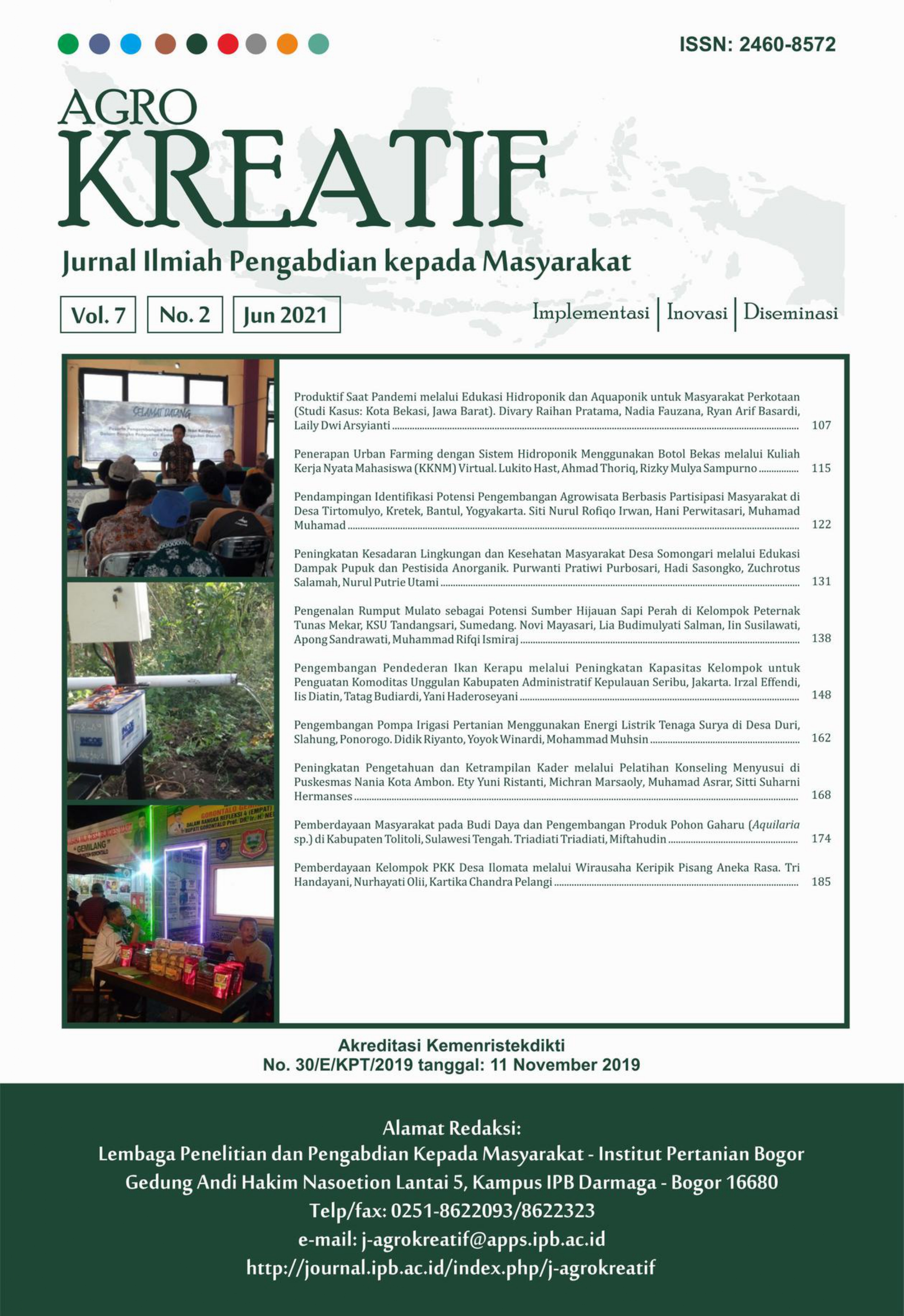Pemberdayaan Masyarakat pada Budi Daya dan Pengembangan Produk Pohon Gaharu (Aquilaria sp.) di Kabupaten Tolitoli, Sulawesi Tengah
Abstract
Tolitoli District has a potential for agarwood trees in the forests, but it has not been optimally utilized and preserved by the local communities. Therefore, efforts are needed to increase understanding and community involvement in cultivation and product development of agarwood trees. The objectives of this activity are: to explore agarwood tree species in the forest and sources of local inoculums using a purposive sampling method for agarwood production, to assess the suitability of agro-climates for agarwood tree cultivation, to conduct face-to-face training and practice for agarwood tree breeding and bio-induction by injection, and to identify socio-economic conditions to support agarwood tree cultivation for community empowerment through product development and cultivation in Kabupaten Tolitoli. The project was implementated by exploring and identifying the existence of natural agarwood trees and agarwood farmers, training, and mentoring. The results of exploration and identification showed that Kabupaten Tolitoli has natural resources of agarwood trees in the forest and local inoculums for the bio-induction of agarwood formation. Also, the local community, including the local government, practitioners, farmers, and educational institutions, have great interest and desire for product development and cultivation of agarwood trees. Thus, it can be concluded that community empowerment through product development and cultivation of agarwood trees in Kabupaten Tolitoli can be implemented.
Downloads
References
Agrios GN. 2005. Plant Pathology. Fifth Edition. USA: Elsevier Academic Press. 922.
Barden A, Anak N, Mulliken T, Song M. 2000. Heart of the matter: Agarwood use and trade and CITES implementation Aquilaria malaccencis. Cambridge (): TRAFFIC International.
Barnett HL, Hunter BB. 1998. Illustrated genera of imperfect fungi. 4th ed. USA: Prentice-Hall, Inc.
[BSN] Badan Standarisasi Nasional. 1999. SNI 01/5009. 1-1999 Gaharu. Jakarta: Badan Standarisasi Nasional Indonesia.
Balai Penelitian Tanah. 2009. Petunjuk Teknis Analisis Kimia Tanah, Tanaman, Air, dan Pupuk. Balai Besar Badan Litbang Sumberdaya Lahan Pertanian, Badan Penelitian dan Pengembangan Pertanian, Departemen Pertanian.
Chippa H, Kaushik N. 2017. Fungal and bacterial diversity isolated from Aquilaria malaccensis tree and soil, induces agarospirol formation within 3 months after artificial infection. Frontiers in Microbiology. 8: artikel 1286. https://doi.org/10.3389/fmicb.2017.01286
Chippa H, Chowdhary K, Kaushik N. 2017. Artificial production of agarwood oil in Aquilaria sp. by fungi: a review. Phytochemistry Reviews. 16: 835–860. https://doi.org/10.1007/s11101-017-9492-6
Chi HK, Hang TTN, Luyen ND, Ha TTH. 2016. Biological characterization of fungal endophytes isolated from agarwood tree Aquilaria crassna Pierre ex Lecomte. Vietnam Journal of Biotecnology. 14(1): 149–156. https://doi.org/10.15625/1811-4989/14/1/9305
Faizal A, Esyanti R, Aulianisa EN, Iriawati, Santoso E, Turjaman M. 2017. Formation of agarwood from Aquilaria malaccensis in response to inoculation of local strains of Fusarium solani. Trees. 31: 189–197. https://doi.org/10.1007/s00468-016-1471-9
Goodman RN, Kiraly Z, Wood KR. 1986. Secondary metabolites. In: Goodman RN, Kiraly Z, Wood KR. (Eds.): The Biochemistry and Physiology of Plant Disease. Columbia (MO): University of Missouri Press. Page: 211–224.
Marlina M, Riniarti M, Syafe’i R. 2018. The effectiveness of bioserum injection on agarwood resin (Aquilaria malaccensis) formation with several injection hole distances. EnviroScienteae. 14 (3): 222–227. https://doi.org/10.20527/es.v14i3.5694
Nobuchi T, Siripatanadilok S. 1991. Preliminary observation of Aquilaria crassna wood associated with the formation of aloewood. Bulletin Kyoto University Forest. 63: 226–235.
Siran SA, Maman T. 2012. Pengembangan teknologi produksi gaharu berbasis pemberdayaan masyarakat. Pusat Penelitian dan Pengembangan Hutan dan Konservasi Alam Kampus Balitbang Kehutanan.
Surata K, Soenarno. 2011. Penanaman gaharu (Gyrinops versteegii (Gilg.) Domke) dengan sistem tumpangsari di Rarung, Provinsi Nusa Tenggara Barat. Jurnal Penelitian Hutan dan Konservasi Alam. 8(4): 349–361. https://doi.org/10.20886/jphka.2011.8.4.349-361
Suhartati, Wahyudi A. 2011. Pola agroforestry tanaman penghasil gaharu dan kelapa sawit. Jurnal Penelitian Hutan dan Konservasi Alam. 8(4): 363–371. https://doi.org/10.20886/jphka.2011.8.4.363-371
Suhartati. 2013. Budi daya tanaman gaharu (Aquilaria malaccensis Lamrk.) di lahan kebun kelapa sawit dengan aplikasi teknik silvikultur. Info Teknis EBONI. 10(1): 37–47.
Triadiati T, Carolina DA, Miftahudin. 2016. Induksi pembentukan gaharu menggunakan berbagai media tanam dan cendawan Acremonium sp. dan Fusarium sp. pada Aquilaria crassna. Jurnal Sumberdaya Hayati. 2(1): 1–6. https://doi.org/10.29244/jsdh.2.1.1-6
Wahyuni R, Triadiati T, Falah S. 2018. Induksi pembentukan gaharu pada Aquilaria malaccensis menggunakan pupuk urea dan Fusarium solani. Jurnal Penelitian Kehutanan Wallacea. 7(2): 165–171. https://doi.org/10.18330/jwallacea.2018.vol7iss2pp165-171
Wangiyana IGAS, Wanitaningsih SK, Anggadhania L. 2020. Pelatihan teknologi bio-induksi untuk petani gaharu Di desa Pejaring, Kabupaten Lombok Timur. Agrokreatif Jurnal Ilmiah Pengabdian Kepada Masyarakat. 6(1): 36-44. https://doi.org/10.29244/agrokreatif.6.1.36-44
Whitmore TC. 1980. An Introduction to Tropical Rain Forests. Oxford (UK): Claredon Press.
This work is licensed under a Creative Commons Attribution-NonCommercial 4.0 International License.



















